
1
M1891 Marlin Right Side
This model 1891 Marlin 2nd variation was manufactured in 1892 and is chambered for .32 Long and Short Colt or .32 Rimfire (RF) Long and Short. The cartridges are loaded through a slot in the magazine tube which was patented by John Marlin in 1892. Currently, .32 Colt and .32 RF Short must be loaded individually through the ejection port. These rifles originally came with two firing pins that the shooter could switch between depending on the ammunition they chose to use. This was believed to be a marketing scheme to attract buyers with the novelty of being able to use both types of lower cost cartridges. It was meant to be particularly attractive to those who reloaded their fired cases.
| 
2
M1891 Marlin Left Side
In many cases, owners would throw out the firing pin for rim fire cartridges once that ammunition became harder to find. Eventually, .32 RF was considered an obsolete cartridge. Fortunately, the previous owner bought both types of firing pins and included two other ejectors as spare parts. This rifle has a standard set of Marlin Rocky Mountain sights; nickel-silver blade in front and Buckhorn with fish-hooked, notched elevator in the rear. This was an improvement over the less desirable rear sight design offered initially.
|
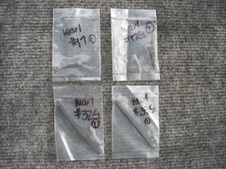
3
M1891 Marlin Parts
The additional parts that were in the baggy hanging from the lever included: a #17 .32 Cal. Early Ejector (requires a screw), a #17G .32 Cal. Later Ejector Assembly with spring, a #32G .32 Cal. Rimfire Firing Pin, and a #33G .32 Cal. Centerfire Firing Pin. According to the Marlin catalog, most parts for the Model 1891 were interchangeable with the Model 1892.
| 
4
M1873 Winchester & M1889 Marlin
The model 1873 Winchester on top is one of 24,826 chambered for .38 WCF (Winchester Center Fire) aka .38-40 Winchester ammunition. It was manufactured in 1899. The magazine tube holds 15 cartridges. The stock has been cleaned up a bit. However, some of the deeper gouges and scratches remain. This was very likely used as a "ranch rifle" owned by the ranch and issued as needed to the hired hands.
The model 1889 Marlin below it is chambered for .32 WCF (Winchester Center Fire) aka .32-20 Winchester ammunition. It was manufactured in 1890. The magazine tube holds 15 cartridges. I added the correct Marbles peep sight I bought from Scott Swamer of Swamer's Antique Gun Sights.
Both rifles have had their barrels relined by Randall Redman & Son of Omak, Washington. I use both of them at Cowboy Action matches.
|

5
M1897 Winchester 16 ga. Hammer Pump Shotgun
This is a model 1897 Winchester 16 gauge take-down pump shotgun with an exposed hammer. It was manufactured in 1916 and sold somewhere in Iowa. The owner told me that it belonged to his father and that his uncle bought one at the same time. I use this in Cowboy Action matches. The action has been reworked and the chamber reamed to accept modern length hulls. The work was done by Martin J. Ahlman, owner of Coyote Cap Gunworks in Morristown, MN.
| 
6
Fulton Ranger Special 16 ga. Double Barrel Shotgun
This appears to be an early Fulton Ranger Special as described in the 2004 Standard Catalog of Firearms 14th Ed. (Krause Pubs.). They came in 12, 16, 20, and .410 ga. The Fulton Ranger Special was a slightly higher grade than the Ranger, featuring "modest" engraving and pointed checkering. The Ranger and Ranger Special models were made by Hunter Arms Company in Fulton, NY from 1890 to 1945.
This example has been modified with a rubber recoil pad and has a sheet metal screw to replace the rear trigger guard screw. It has checkering and what appears to be "engraving" in the form of light scrolling, but I would call it stamped. I had gunsmith Nick Martini of Winnebago, IL shorten it to coach length (20 in.) and add a bead sight for use at cowboy matches.
|

7
M1894 Winchester Extra Light Weight Rifle
This model 1894 Winchester chambered for .30 WCF (Winchester Center Fire) aka .30-30 Winchester ammunition, appears to be a special order Extra Light Weight Rifle. The barrel is 21 inches long with a half-magazine tube and has a crescent butt-plate. Flayderman's Guide to Antique Firearms describes them as having a 22 inch barrel and shotgun butt-plate.
This rifle was manufactured in 1906. It has a period-correct LB1 receiver peep sight from Pacific Gunsight Company with a Marbles dovetail blank replacing the standard buckhorn ramp sight. In addition to the standard patent dates and caliber, it is also marked: "Nickel Steel Barrel Especially for Smokeless Powder". With cowboy loads and LRN bullets (PMC ammunition), it makes 3-inch groups at 100 yards.
From the appearance of wear on the later half of the butt stock, it may have spent considerable time in a leather scabbard.
| 
8
Remington #4 & Springfield Meteor Boy's Rifles
The Remington #4 rolling block rifle on top is chambered for .32 RF (rimfire) Short or Long ammunition. It was manufactured around 1907. Approximately 356,000 were produced between 1890 and 1933. The main spring was replaced with a new reproduction from Wisner's, Inc. .32 RF ammunition is considered obsolete. The last runs were made in Brazil by CBC (Companhia Brasileira De Cartuchos) for Navy Arms Company. I have boxes of both .32 RF Short and Long cartridges. Some .32 RF Long ammunition has recently appeared under the Navy Arms Company label and was being distributed by Southern Ohio Gun.
The Savage Springfield Meteor single shot bolt rifle below it is chambered for .22 LR (long rifle) ammunition and was manufactured around 1920. Because it does not have a magazine, each cartridge is loaded in to the receiver individually.
|

9
Early No. 17 Stevens Favorite Boy's Rifle
This No. 17 Stevens Favorite is an early 1894 take-down model with a 20-inch round-to-half-octagon barrel chambered for .22 LR (long rifle) ammunition. It features a "7 o'clock" ejector with a slightly different forend and butt-stock from the late 1894 model. It has been relined by Randall Redman of Redman & Son in Omak, Washington. The wood was cleaned up by fellow CMP shooter, Rollie Faber.
My 8 yr. old son, James, likes this one because it's shorter. Now that it has been relined, he's been getting better results.
| 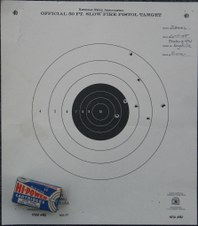
10
James' First Target
On June 11, 2005 (three days after his 5th birthday) my youngest son joined his two older brothers and sister at the Sycamore range. This is the result of firing .22 RF Shorts through my early 1894 Stevens Favorite Boy's rifle from the prone position at 30 yards. Note that this is before I had the barrel relined.
We spent some time at home running through safety rules, range etiquette, and dry-fire drills in preparation. All things considered, he did a pretty good job!
|

11
Late No. 17 Stevens Favorite Boy's Rifle
This No. 17 Stevens Favorite is a late 1894 take-down model with a pivoting (swinging) block action chambered for .22 LR (long rifle) ammunition. The 26-inch full octagon barrel was relined by Randall Redman of Redman & Son in Omak, Washington.
When my triplets, Andrew, Matt & Rachel, were 12 yrs. old they really like shooting this because it fit them and punches plenty of holes in the black part of a pistol target.
Andrew has gone on to join the Illinois State Rifle Association's Junior High Power rifle team, the Illinois Hard Dogs. He discovered that M1 Carbines, AR-15s, and now M1903s are great fun to shoot.
| 
12
Winchester 67A with Weaver Scope
This is a model 67A Winchester single-shot, .22 caliber bolt-action rifle with Weaver G4 scope. It has a 27-inch barrel with a later-production plain stock that is similar to that of the model 60. It is marked for .22 Short, .22 Long, and .22 Long Rifle rimfire ammunition. The model 67A was manufactured from 1934 to 1963. As of 2013 it is officially a Curio & Relic. The early model stocks had finger-grooves. Some of these came with the scope as part of the package. Winchester also made a boy's model that had a shorter stock and barrel. This late model appears to be in good to very good condition.
|
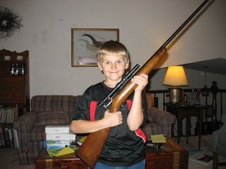
13
James and His Winchester 67A Rifle
For James' 10th birthday in 2010, his older brother and I decided to present him with the Winchester. Note that the bolt is open and his finger is off the trigger. He is very good about safe handling.
After his baseball playoffs were over, we took it to the Sycamore range on Father's Day. He wanted to take a crack at his Barney target.
| 
14
M67 Winchester
This is a model 67 Winchester single-shot, .22 caliber bolt-action rifle. It has a 27-inch barrel with a later-production plain stock that is similar to that of the model 60. It is marked for .22 Short, .22 Long, and .22 Long Rifle rimfire ammunition. The model 67 was manufactured from 1934 to 1963. As of 2013 it officially became a Curio & Relic. The early model stocks had finger-grooves. Some of these came with the scope as part of the package. Winchester also made a boy's model that had a shorter stock and barrel. This late model appears to be in very good condition.
|

15
M36 Ranger by Marlin
This is a Marlin Ranger Model 36 single-shot, .22 caliber bolt-action rifle. It is part of the Marlin Model 80 series. It is marked for .22 Short, .22 Long, and .22 Long Rifle rimfire ammunition. The Model 36 Ranger was manufactured from 1934 to 1939. Marlin also made a boy's model that had a shorter stock and barrel. I found this at Marengo Guns on Black Friday weekend for an additional 25% off.
| 
16
Wesson & Harrington 1871 Buffalo Classic
This is a modern made Wesson & Harrington M1871 Buffalo Classic chambered for .45-70 Government ammunition. Since it came without sights, I added a Lyman 17A globe sight in front and a Williams WGOS interchangeable blade sight in the rear. This model is also drilled for a scope, which seems out of keeping with the design.
Before the company was acquired by Marlin, I had the H&R 1871, LLC factory install a stock weight, blued-steel trigger guard, and blued-steel forend spacer.
It is now sold as the Harrington & Richardson Buffalo Classic (under the Marlin brand) and includes a Lyman 17A front sight with a Williams peep sight.
|
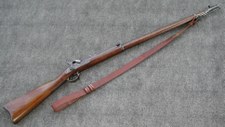
17
M1873 Springfield Rifle
This is an original M1873 rifle manufactured by the Springfield Armory in June of 1879. It's shown here with a reproduction M1887 sling (in firing position) from Pat Wolf of Wolf's Western Traders in Greybull, WY (www.the45-70book.com). Pat co-authored "Loading Cartridges for the Original .45-70 Springfield Rifle and Carbine" with her late husband, Spence. I gave the rifle a "field upgrade" by adding an M1884 Buffington rear sight & barrel band. I also added a final issue bronze alloy firing pin and a snap-on front sight hood.
| 
18
M1898 U.S. Krag Magazine Rifle
This M1898 U.S. Krag magazine rifle, chambered for .30 Army/.30-40 Krag ammunition, was manufactured by the Springfield Armory in 1899. The side-opening magazine holds 5 cartridges. It has a period correct Redfield 102-K micrometer rear sight. I also added an expertly made M1903 reproduction sling from Turner Saddlery Co.
I've found that 220 gr. jacketed soft point cartridges by handloader, Glenn Anderson of Cape Coral, FL are extremely accurate. Commercial 180 gr. cartridges do not group well at 100 yds.
|

19
M1903 Rock Island Bolt Rifle
This CMP M1903 rifle was manufactured at the Rock Island Armory in 1919 (and very likely assembled in the 1920s) is chambered for .30-06 Springfield ammunition. It has a "C" stock and was re-barreled during WWII (stamped H.S. for High Standard, a flaming ordinance bomb, and dated 5-44).
In 2003 the CMP received some 60,000 that were part of the WWII lend-lease program. About 10% were returned by the Greek government who must have "lost" them in a warehouse (recall the final scene in "Raiders of the Lost Ark" where they put the Ark in an Area 51 warehouse).
I took this to the 2003 Centenial CMP Matches and fired it in both the John C. Garand Match and Springfield Bolt Rifle Match.
| 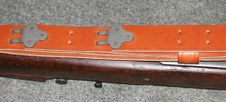
20
Turner Saddlery M1907 Sling Hardware
This is the sling I purchased for use with my M1903 Rock Island. Note the Parkerized Steel, WWII type hardware. (The WWI type used brass hardware.)
|
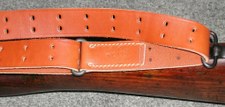
21
Turner Saddlery M1907 Sling Date
This view of the sling shows the level of detail that Turner goes to for authenticity. Note the flaming bomb U.S. ordnance mark followed by his company mark (T.S.CO.) along with the month and year of production (3-02).
| 
22
Mossberg M44US Training Rifles
These M44US training rifles chambered for .22 RF (rimfire) ammunition came to me from the CMP in two finishes: blued and Parkerized. Both were in plastic packages and appear to have received very little use, if any. However, both plastic trigger guards had become very brittle and had to be replaced with reproductions from Havlin Sales & Service, a Mossberg parts dealer. The Parkerized rifle was made in 1943 under Ordinance Contract Number: W-478-ORD-3125 as one of 14,500. The blued rifle was made in 1944 under Ordinance Contract Number: W-19-059-ORD-2378 as one of 13,200.
When my dad was in the U.S. Army during WWII, he shot rifles like this for practice while at Ft. Devons.
|

23
1943 Remington 513-T Target Match Master
This is the first U.S. Property marked Remington 513-T Target Match Master I bought through the CMP. It is chambered for .22 Long Rifle ammunition. The receiver is marked "MILITARY FINISH". It was one of 31,104 model 66400 M-13 (Military Designation) rifles. It was supplied through U.S. Government Springfield Ordnance Contract Number W-740-ORD-2577, dated 1942-43.
On the left side of the barrel at the receiver line is WMM (date code for August, 1943) and on the right side is a 6-pointed star next to a small circular mark with four rays (like a compass). Nearby are four small undecipherable marks. The stock has several cartouches: RIA over EB in a box (Rock Island Armory/Elmer Bjerke) on the right side of stock and FJA (Frank J. Atwood, IIRC) on the left side. The number "3" painted in yellow on the bottom of the grip cap, and an almost completely obliterated "P" (overhaul proof mark) between the grip cap and trigger housing.
I added a period correct No. 75 Redfield...
| 
24
1942 Remington 513-T Target Match Master
This is the second U.S. Property marked Remington 513-T Target Match Master I bought through the CMP. It too was one of 31,104 model 66400 M-13 rifles supplied through U.S. Government Springfield Ordnance Contract Number W-740-ORD-2577, dated 1942-43.
On the left side of the barrel at the receiver line is XL (date code for December, 1942) and on the right side at same place is a 6-pointed star next to a small circular mark with four rays (like a compass). Nearby are four small undecipherable marks. The stock has two sets of initials: LK (unknown inspector) and AN (Anniston Army Depot) on the left side. The block letter "P" (overhaul proof mark) is stamped between the grip cap and trigger housing.
Again, I added a period correct No. 75 Redfield micrometer peep sight from Scott Swamer of Swamer's Antique Gun Sights, an M1 Garand web sling from the CMP, two 10-round magazines plus two 5-round magazines from Brownell's, and a vintage Redfield International Olympic G.I. front sight.
|

25
Mle.1949-56 French MAS Commando Rifle
This is a Mle.1949-56 French MAS (Manufacture d'Armes de Saint-Etienne) semi-automatic commando rifle chambered for 7.5mm x 54mm French ammunition and equipped with a grenade launching front sight. This partially refurbished (arsenal) example was issued to French Foreign Legion troops for use in French Indo-China during the late 1940s and early 1950s. It came with an unissued, sealed bag that contained a tool kit, a manual (in French), a bayonet & scabbard, a grenade firing device, a slip-on recoil butt pad, a new sling, three 10-round magazines, and new magazine pouches with belt. It accepts the same stripper clips used on the Mle. 1936 bolt rifle to reload the magazine.
It will only cycle properly with corrosive French surplus ammo or Serbian made Prvi Partizan (PPU) commercial ammo. Earlier production Portuguese INDEP ammo does not eject fast enough, causing the cases to get stuck side-ways between the bolt and chamber. INDEP recently reformulated the loads to fix this problem.
| 
26
Mle.1936-51 French MAS
This is a Mle.1936-51 French MAS (Manufacture d'Armes de Saint-Etienne) bolt rifle chambered for 7.5mm x 54mm French ammunition. It is equipped with a reinforced barrel with a grenade launching front sight. It came with an unissued, sealed bag that contains a manual (in French), a slip-on recoil butt pad, pull through with twine, and a new sling. The -51 designation means that is it is capable of launching anti-tank and anti-personnel grenades. It can fire both 73mm M1950 and 65mm M1961 anti-tank grenades as well as 34mm M1952 anti-personnel grenades. Additionally, it can fire 34mm M1950/M60 and 40mm M1956 duel purpose rifle grenades capable of penetrating 120mm of steel. An arsenal tag (in French) was attached that dates to January of 1975.
|

27
M44 Russian Mosin-Nagant Carbine
This M44 carbine is either expertly arsenal refinished or unissued. The receiver is stamped 1948 and all components have matching numbers (correct for the the serial number). It is chambered for 7.62mm x 54mm Russian ammunition. Note the new reproduction "dog-collar" sling I bought on Vendor's Row at Camp Perry while participating in the 1903-2003 Centennial National Matches.
The M44 has a folding bayonet that replaces the detachable type on older models. As late as the Viet Nam War, the Type 53 (Chinese) was standard issue to the Viet Cong. Polish examples of this rifle were captured in Granada during the invasion by U.S. Troops. More recently, M44s have seen service in the Balkans and Chechnya as well as during the Soviet occupation of Afghanistan. I imagine our troops in Iraq and Afghanistan are finding these in the hands of the Taliban and foreign insurgents.
| 
28
M1891/30 Russian Mosin-Nagant Rifle
This model 1891/30 Mosin-Nagant rifle has been arsenal reworked, with the barrel and action in original finish. The stock has been lightly refinished along with the trigger guard/magazine well. The receiver is stamped 1936 and all components have matching numbers (correct for the the serial number). It is chambered for 7.62mm x 54mm Russian ammunition. The rifle came with a spike bayonet, tools, an oiler, cartridge holder, and unissued "dog-collar" sling. The cartridge holder is dated 1962. I guess the Soviets were hanging on to their older small arms. This would be the equivalent of our military issuing M1903s during the Vietnam War era.
|
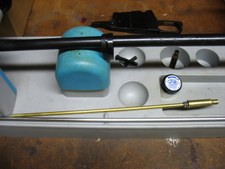
29
Mosin-Nagant Chamber Cleaning Tool
To clean out the chamber of the Mosin-Nagant rifle, I created my own tool. After drilling out the primer hole, I inserted a machine bolt through the head. Then tightened it in place with two nuts; one to snug up the machine bolt and the other to keep the nut from loosening while spinning. I then slipped a brass tube over the length of the machine bolt, which was covered in epoxy. To clean the chamber, I put some J-B Compound from Brownell's on the outside of the case and used my electric drill to spin it. Hopefully, the result will allow fired cases to eject easier.
| 
30
Harrington and Richardson 852 Fieldsman
This is a Harrington & Richardson Arms Model 852 Fieldsman chambered for .22 short-long-long rifle rimfire. The tubular magazine holds 17 short, 16 long, and 15 long rifle rimfire cartridges. It does not have a serial number, but has a year code of M. They were only made in 1952 and 1953. M indicates that it was made in 1952.
|

31
M1 Garand Rifle
This CMP M1 Garand rifle was manufactured at the Springfield Armory in 1943 is chambered for .30-06 Springfield ammunition. It most was most likely used in action during WWII and possibly Korea. This image shows it with my reproduction M1907 sling by Turner Saddlery.
After the war it was rebuilt and re-Parkerized. The forearm and handguard probably came from different rifles. I replaced the poorly repaired butt-stock with another stock from an online C&R dealer. If you look closely at the wood between the trigger assembly and the bolt, you'll see 8 tiny dimples in the wood. This was caused by a soldier who slammed a loaded enbloc into the side of his rifle to reduce a long round. This would have brought a great deal of wrath from his sargent had he done it anywhere else but in combat. The two off-set, larger holes are likely from a grenade launching sight.
I use this rifle at local CMP Matches & Clinics and in the summer of 2006 for the John C. Garand National Match a...
| 
32
M1 Garand Receiver
This is a close-up view of the receiver. The CMP continues to sell these rifles. However, the various grades are slowly disappearing from their stock. The Standard Grade and Collector Grade rifles were pretty much sold out by 2007. All that are left are the Rack Grade and stripped receivers. The Rack Grades consist mainly of Danish and Greek returns left over from the WWII Lend-Lease Program.
|
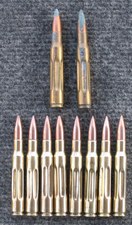
33
M40 Functional Brass Dummies
This is a set of ten non-functional .30-06 Springfield dummy rounds used for demonstration and dry-fire exercises. I found them at Trader John's Outpost Army Surplus store in South Elgin, IL. The top two show how tarnished they were (they were in a shoe box with several dozen others.) After cleaning them with Flitz, they look a bit better. All ten have the flash-holes drilled out with no holes in the sidewalls. The M40 brass cases have six "flutes" (grooves running along the case). All have head stamps marked FA 44 (Frankford Arsenal 1944). The Frankford Arsenal in Philadelphia, PA operated from 1816 to 1977.
| 
34
Unissued M1906 Box with Steel Dummies
The box of twenty M1906 cartridges contains a set of unissued .30-06 Springfield M40 non-functional dummies (similar to the ones in the previous image) on brass stripper clips. The head stamp is marked FA 43 (Frankford Arsenal 1943). Below the box is a set of steel experimental smooth-case dummies without flutes and with three holes in the case sidewalls. They are marked FA 4 (most likely Frankford Arsenal 1944). These work well for dry-fire exercises.
I can't remember where I found the box or the steel dummies.
|

35
Fulton Armory FAR-15
This is a Fulton Armory Classic M16A2-style standard black rifle with a 20-inch, Chrome-lined heavy barrel. It is chambered for 5.56x45mm NATO/.223 Remington ammunition and came with a five-round plastic magazine as well as a signed copy of "The Complete AR-15 Owner's Guide" by Walt Kuleck & Scott Duff. They state that one can expect 1 MOA accuracy.
I added a black M1907-type National Match Service Rifle All-Weather Sling made for the CMP by Tuner Saddlery. Go to the next image to see a close-up view.
In the year 2055 this will be considered a C&R; if the U.S. Government still allows us to have them.
| 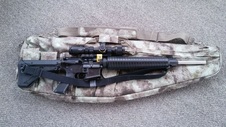
36
Fulton Armory FAR-15 NM Configured
Over the years, I realized that to compete with this rifle it would need to be upgraded to meet National Match (NM) standards. The upper is a NM A4 from White Oak. It has a steel float tube and a heavy barrel with 7.5:1 twist. It now has a Hi-Lux XTC scope with Reaper mount. The Hi-Lux XTC14X34 scope was specifically designed for CMP and NRA High Power "Across the Course" Competition. It has a Geissele Automatics 2-stage national match trigger with a B.A.D. Lever to release the bolt now that the scope and mount blocks the standard release. It also has a Magpul UBR Gen I adjustable stock with a 1 pound triangular cavity weight. I switched back to a canvas military-style sling with a push-button QD swivel sling release.
I found a soft case on sale at Farm & Fleet. It is easier to use at a match.
|
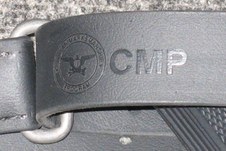
37
CMP Turner All-Weather Sling
This close-up shows the CMP logo on the National Match Service Rifle All Weather Sling custom made for the CMP by Turner Saddlery (available exclusively from the CMP). This 54-inch sling is styled after the M1907 mil. spec. shown on my M1903 Rock Island and M1 Garand, but made from a synthethic materal known as Biothane. It also has Parkerized Steel, WWII type hardware. It will be a while before it's broken in. Right now it's hard to slide the keepers and even harder to set the hooks.
According to Turner, it "Will not crack, stretch, slip nor break... Biothane has the same flex and feel as a well-broken-in sling... Breaking strength prior to hole punching is in excess of 2300 lbs; holes are rated in excess of 250 ft lbs tear out ratio."
| 
38
Fulton Armory FAR-15 RRAGE Upper
As an alternative, I got a Rock River Arms RRAGE 16-Inch Upper with M-LOK handguard and used my Fulton Armory Lower with Geissele Automatics 2-Stage match trigger. It retains the MAGPUL UBR Gen I butt stock. For the carbine upper, I switched to an AR-STONER H1 heavy buffer. I added a MAGPUL M-LOK MVG Vertical Grip. It has a detachable Holosun Technologies Green Dot battery and solar panel powered holographic sight with UTG ACCU-SYNC 45-degree flip-up front & rear sights. I switched out the charging handle for a Presma Ambidextrous charging handle and added a Daniel Defense Rail Mount QD Point with swivel sling disconnect on a Picatinny rail mount.
|

39
Winchester Model 70 Long Range Target Rifle
This Winchester Target Model 70 Bolt Action rifle was one of 16,095 manufactured in 1970. It has an 8:1 twist 26-inch heavy match barrel chambered in .223 Remington. It has the same Vintage Redfield International Olympic front sight and No. 75 Redfield micrometer peep sight at the rear as on my two Remington 513-T U.S. Matchmaster target rifles. If I wanted to add a scope, it does have scope mounts. It weighs 15.6 lbs. I added a Field's Custom Rifle Sling that is used in prone matches. The rifle can be used in Mid-Range matches at 300, 500, and 600 yards. And, can be used in Long-Range/Palma matches at 800, 900, and 1,000 yards. Bullets used are either 69, 75, or 77 grain match FMJ. Anything heavier with this 8:1 twist barrel and the bullets would start to tumble by 800 yards.
| 
40
Marlin Model 1898 Exposed Hammer Model 16
This Marlin Model 1898 M16 exposed hammer shotgun is in 16 gauge only. The M16 was manufactured between 1903 and 1910. This was likely made in 1910 as a Grade A based on the serial number.
|

41
Czech BRNO Model 581
This is a Czech BRNO Model 581 semi-auto .22 LR with Nikko Sterling Silver Crown 4X40 scope and 10-shot magazine from The Old Western Scrounger in Martinsburg, WV. It was manufactured April 1973. This model was later reintroduced by CZ as the Model 511.
| 
42
BSA Martini M12-15 Target Rifle
This a .22 LR BSA M12-15 Target Rifle. The rear sight is a Parker-Hale Model 7A and the front sight is a Parker-Hale Model 2 with interchangeable inserts (stored in a cap under the handguard). The rear peep is a Merit Corporation #3 Target Disk with adjustable aperture.
A fellow member of the Wheaton Rifle Club took this to his home shop and did some great restoration work. He inlet the fore end for a palm rest and for a sling swivel/handstop, plugged 3 holes, filled the chip on the buttstock, and refinished the wood. He also carded and re-blued the barrel & action taking care to leave the markings and made a new screw for the side of the action.
|